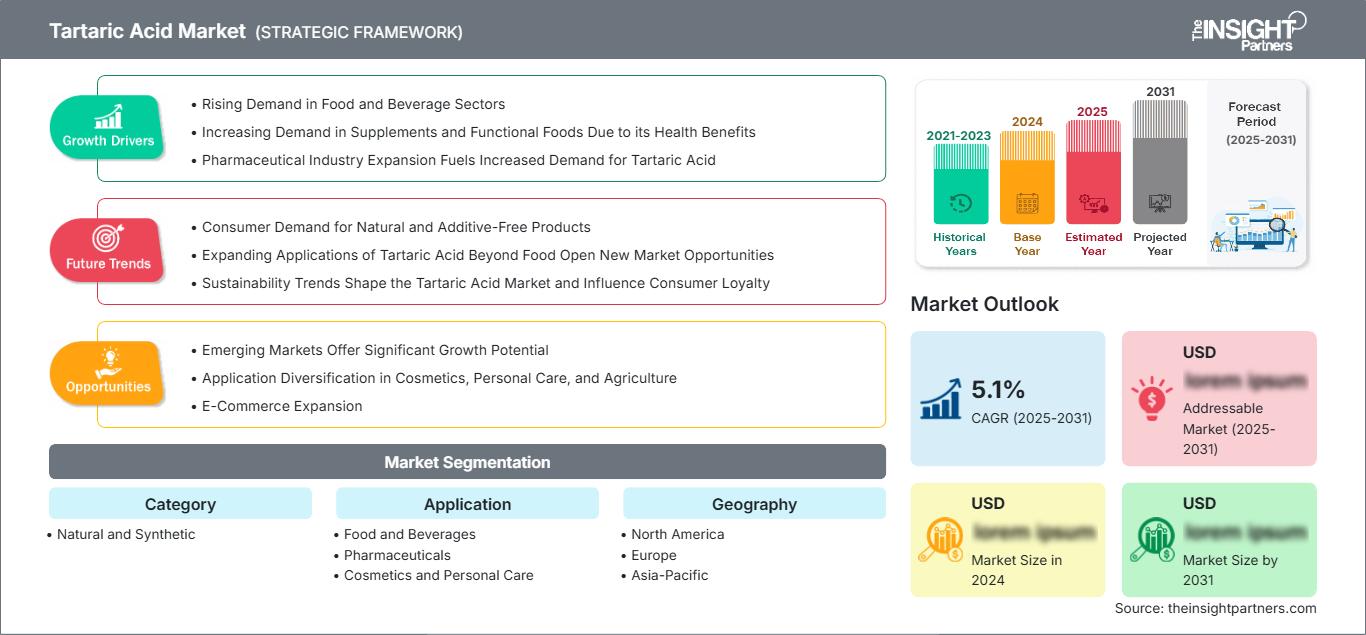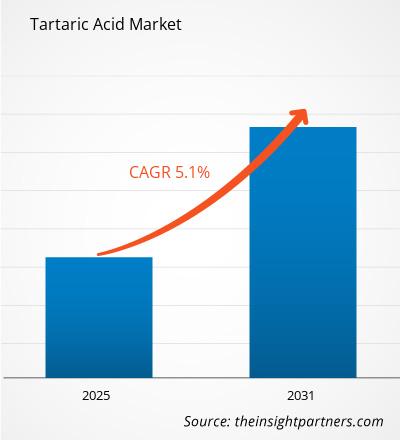Si prevede che il mercato dell'acido tartarico registrerà un CAGR del 5,1% dal 2025 al 2031, con una dimensione del mercato in espansione da XX milioni di dollari nel 2024 a XX milioni di dollari entro il 2031.
Il rapporto è segmentato per categoria (naturale e sintetica). Il rapporto presenta inoltre un'analisi basata sull'applicazione (alimenti e bevande, prodotti farmaceutici, cosmetici e cura della persona e altri). L'ambito del rapporto copre cinque regioni: Nord America, Europa, Asia Pacifico, Medio Oriente e Africa, America meridionale e centrale e i paesi chiave di ciascuna regione. L'analisi globale è ulteriormente suddivisa a livello regionale e per paesi principali. Il rapporto offre il valore in USD per l'analisi e i segmenti sopra indicati.
Scopo del rapporto
Il rapporto "Tartaric Acid Market" di The Insight Partners mira a descrivere il panorama attuale e la crescita futura, i principali fattori trainanti, le sfide e le opportunità. Ciò fornirà approfondimenti a vari stakeholder aziendali, come:
- Fornitori/produttori di tecnologia: per comprendere le dinamiche di mercato in evoluzione e conoscere le potenziali opportunità di crescita, consentendo loro di prendere decisioni strategiche informate.
- Investitori: per condurre un'analisi completa delle tendenze in merito al tasso di crescita del mercato, alle proiezioni finanziarie di mercato e alle opportunità esistenti lungo la catena del valore.
- Organismi di regolamentazione: per regolamentare le politiche e le attività di polizia nel mercato con l'obiettivo di ridurre al minimo gli abusi, preservare la fiducia degli investitori e sostenere l'integrità e la stabilità del mercato.
Categoria di segmentazione del mercato dell'acido tartarico
- Naturale e sintetico
Applicazione
- Alimenti e bevande
- Prodotti farmaceutici
- Cosmetici e cura della persona
- Altri
Potrai personalizzare gratuitamente qualsiasi rapporto, comprese parti di questo rapporto, o analisi a livello di paese, pacchetto dati Excel, oltre a usufruire di grandi offerte e sconti per start-up e università
Mercato dell'acido tartarico: Approfondimenti strategici

-
Ottieni le principali tendenze chiave del mercato di questo rapporto.Questo campione GRATUITO includerà l'analisi dei dati, che vanno dalle tendenze di mercato alle stime e alle previsioni.
Fattori di crescita del mercato dell'acido tartarico
- Crescente domanda nel settore alimentare e delle bevande: la crescente domanda di alimenti e bevande aumenta la crescita del mercato dell'acido tartarico. Il suo utilizzo nella produzione di vino come stabilizzante e acidificante e in prodotti alimentari come lieviti in polvere e cremor tartaro ne aumenta la domanda. L'aumento del consumo di alimenti e bevande trasformati a livello globale aumenta le opportunità di ulteriore crescita di questo prodotto nel mercato mondiale.
- Crescente domanda di integratori e alimenti funzionali grazie ai suoi benefici per la salute: la crescente consapevolezza dei benefici per la salute dell'acido tartarico è un fattore importante per la sua espansione di mercato. Contiene proprietà antiossidanti; di conseguenza, il suo utilizzo è in costante aumento negli integratori alimentari e negli alimenti funzionali. Poiché la consapevolezza della salute dei consumatori è in aumento, insieme alla richiesta di benefici nutrizionali dei prodotti, le applicazioni sanitarie sempre più esigenti alimentano ulteriormente l'attrattiva dell'acido tartarico sul mercato.
- L'espansione dell'industria farmaceutica alimenta l'aumento della domanda di acido tartarico: a questo proposito, l'espansione dell'industria farmaceutica ha un impatto positivo sul mercato dell'acido tartarico. L'acido tartarico è un eccipiente utilizzato nelle formulazioni farmaceutiche per migliorarne la stabilità e l'efficacia. Poiché la domanda nel settore farmaceutico è al suo apice e in continuo aumento in molti mercati in via di sviluppo, aumenta la domanda di acido tartarico nelle applicazioni farmaceutiche, stimolando così il mercato di questo acido.
Tendenze future del mercato dell'acido tartarico
- Domanda dei consumatori di prodotti naturali e senza additivi: i consumatori sono sempre più interessati a prodotti che sembrino naturali e non contengano additivi artificiali; pertanto, i produttori devono sviluppare tali prodotti partendo da fonti di origine naturale. Questo non solo giova al senso estetico, ma spinge anche le aziende a migliorare la qualità e a creare formulazioni più salutari.
- L'espansione delle applicazioni dell'acido tartarico oltre l'ambito alimentare apre nuove opportunità di mercato: negli ultimi anni, i produttori hanno aumentato l'uso dell'acido tartarico in numerosi prodotti cosmetici, per la cura della persona e agricoli. Pertanto, l'espansione oltre il settore alimentare e delle bevande influisce sulla capacità delle aziende di entrare in nuovi mercati e di adattarsi ai mutevoli stili di vita dei consumatori.
- Le tendenze della sostenibilità plasmano il mercato dell'acido tartarico e influenzano la fidelizzazione dei consumatori: una maggiore attenzione alla sostenibilità trasformerà il funzionamento del mercato dell'acido tartarico. Pertanto, ci sono più consumatori che richiedono prodotti ecocompatibili provenienti da fonti sostenibili. Di conseguenza, i produttori hanno risposto alla domanda e modificato metodi e politiche per essere rispettosi dell'ambiente. Ciò non solo darebbe una spinta alla costruzione della reputazione del marchio, ma lavorerebbe anche direttamente con i valori dei consumatori, favorendo la fedeltà e decisioni di acquisto responsabili in un mercato così competitivo.
Opportunità di mercato per l'acido tartarico
- I mercati emergenti offrono un potenziale di crescita significativo: i mercati emergenti rappresenterebbero opzioni di crescita cruciali per il mercato dell'acido tartarico, con l'aumento dei redditi e i cambiamenti nella dieta che portano a prodotti alimentari e bevande. Poiché questi mercati si stanno sviluppando, la domanda di ingredienti per la vinificazione e di ingredienti alimentari trasformati come l'acido tartarico aumenta. Sfruttando questo mercato in forte espansione, i produttori possono formulare prodotti adatti ai gusti e alle preferenze locali.
- Diversificazione delle applicazioni in cosmetici, cura della persona e agricoltura: le maggiori opportunità per l'acido tartarico al di fuori di alimenti e bevande si trovano nella diversificazione delle applicazioni. Cosmetici, cura della persona e agricoltura stanno iniziando a incorporarlo per le sue proprietà stabilizzanti e antiossidanti. A questo proposito, i produttori possono espandere il loro portafoglio prodotti, ottenendo al contempo maggiori ricavi attraverso nuovi mercati e aumentando la loro portata e influenza.
- Espansione dell'e-commerce: l'e-commerce offre opportunità di crescita per il mercato dell'acido tartarico. Mentre i consumatori semplificano sempre di più gli acquisti online, i marchi sono in grado di raggiungerli rapidamente tramite piattaforme digitali, consentendo ai produttori di ottenere visibilità su un maggiore accesso e vendite. Puntando a un aumento delle vendite dirette al consumatore, unito a una presenza online più forte, i produttori possono raggiungere un pubblico più ampio, migliorare le vendite e connettersi con consumatori più sani che cercano prodotti di qualità.
Approfondimenti regionali sul mercato dell'acido tartarico
Le tendenze regionali e i fattori che influenzano il mercato dell'acido tartarico durante il periodo di previsione sono stati ampiamente spiegati dagli analisti di The Insight Partners. Questa sezione illustra anche i segmenti e la geografia del mercato dell'acido tartarico in Nord America, Europa, Asia-Pacifico, Medio Oriente e Africa, America meridionale e centrale.
Ambito del rapporto di mercato dell'acido tartarico
| Attributo del rapporto | Dettagli |
|---|---|
| Dimensioni del mercato in 2024 | US$ XX million |
| Dimensioni del mercato per 2031 | US$ XX Million |
| CAGR globale (2025 - 2031) | 5.1% |
| Dati storici | 2021-2023 |
| Periodo di previsione | 2025-2031 |
| Segmenti coperti |
By Categoria
|
| Regioni e paesi coperti |
Nord America
|
| Leader di mercato e profili aziendali chiave |
|
Densità degli operatori del mercato dell'acido tartarico: comprendere il suo impatto sulle dinamiche aziendali
Il mercato dell'acido tartarico è in rapida crescita, trainato dalla crescente domanda da parte degli utenti finali, dovuta a fattori quali l'evoluzione delle preferenze dei consumatori, i progressi tecnologici e una maggiore consapevolezza dei benefici del prodotto. Con l'aumento della domanda, le aziende stanno ampliando la propria offerta, innovando per soddisfare le esigenze dei consumatori e sfruttando le tendenze emergenti, alimentando ulteriormente la crescita del mercato.

- Ottieni il Mercato dell'acido tartarico Panoramica dei principali attori chiave
Punti di forza
- Copertura completa: il rapporto copre in modo completo l'analisi di prodotti, servizi, tipologie e utenti finali del mercato dell'acido tartarico, fornendo un panorama olistico.
- Analisi di esperti: il rapporto è compilato sulla base della conoscenza approfondita di esperti e analisti del settore.
- Informazioni aggiornate: il rapporto garantisce rilevanza aziendale grazie alla sua copertura di informazioni recenti e tendenze dei dati.
- Opzioni di personalizzazione: questo rapporto può essere personalizzato per soddisfare le esigenze specifiche del cliente e adattarsi in modo appropriato alle strategie aziendali.
Il rapporto di ricerca sul mercato dell'acido tartarico può, quindi, aiutare a guidare il percorso di decodificazione e comprensione dello scenario del settore e delle prospettive di crescita. Sebbene possano esserci alcune preoccupazioni valide, i vantaggi complessivi di questo rapporto tendono a superare gli svantaggi.
- Analisi storica (2 anni), anno base, previsione (7 anni) con CAGR
- Analisi PEST e SWOT
- Valore/volume delle dimensioni del mercato - Globale, Regionale, Nazionale
- Industria e panorama competitivo
- Set di dati Excel
Report recenti
Rapporti correlati
Testimonianze
Motivo dell'acquisto
- Processo decisionale informato
- Comprensione delle dinamiche di mercato
- Analisi competitiva
- Analisi dei clienti
- Previsioni di mercato
- Mitigazione del rischio
- Pianificazione strategica
- Giustificazione degli investimenti
- Identificazione dei mercati emergenti
- Miglioramento delle strategie di marketing
- Aumento dell'efficienza operativa
- Allineamento alle tendenze normative






















 Ottieni un campione gratuito per - Mercato dell'acido tartarico
Ottieni un campione gratuito per - Mercato dell'acido tartarico